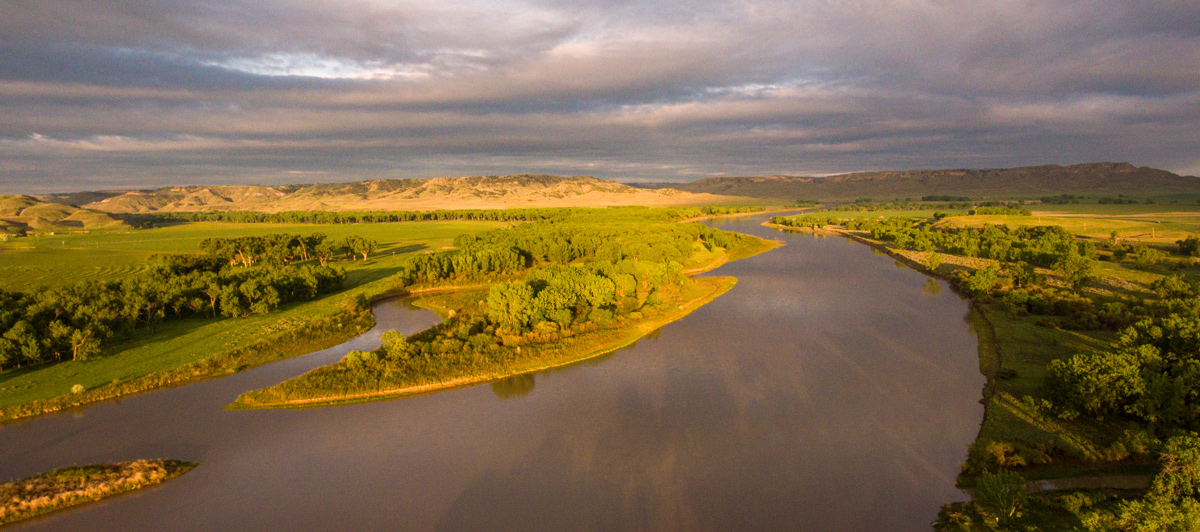The men tow the boats twenty miles reaching the fertile Judith River Basin. Lewis finds the change in scenery reviving. Several Native American items are found floating down the river, and they worry that Indians are not far ahead. In St. Louis, military commander James Bruff proposes a mission for the expedition’s old barge.
Judith River Basin
© 24 May 2016 by Kristopher K. Townsend. Permission to use granted under the Creative Commons Attribution-Share Alike 4.0 International license.
here the hills recede from the river on both sides . . . . the land again fertile. These appearances were quite reviving after the drairy country through which we had been passing.
—Meriwether Lewis
Elk Skin Rope
Historical interpretation by John W. Fisher. Photo © 2011 by Kristopher K. Townsend. Permission to use granted under the Creative Commons Attribution-Share Alike 4.0 International license.
Precarious Towing
our ropes are but slender, all of them except one being made of Elk’s skin and much woarn, frequently wet and exposed to the heat of the weather are weak and rotten; they have given way several times in the course of the day but happily at such places that the vessel had room to wheel free of the rocks and therefore escaped injury;
—Meriwether Lewis
Rounding Shoaly Places
a Cloudy morning Some fiew drops of rain and verry Smokey wind from the S. W. we Set out at an early hour, the Shoaley places are verry numerous and Some bad to get around
—William Clark
Indian Signs
found a new indian lodge pole today which had been brought down by the stream, it was woarn at one end as if draged by dogs or horses; a football also, and several other articles were found, which have been recently brought down by the courant; these are strong evedences of Indians being on the river above us
—Meriwether Lewis
Weather Diary
State of thermometer at rise
Weather Wind at rise
State of thermometer at 4 P. M. Weather Wind at 4 P. M. State of the river 62 [above 0] cloudy S W 72 [above 0] cloudy & rain S W raised ½ in. a slight thundershower; the air was turbid in the forenoon and appeared to be filled with smoke; we supposed it to proceed from the burning of the plains, which we are informed are frequently set on fire by the Snake Indians to compell the antelopes to resort to the woody and mountanous country which they inhabit.— saw a small white and black woodpecker with a red head; the same which is common to the Atlantic states.—
—Meriwether Lewis[1]To assist the reader, the editor of this web page has omitted the date column, merged the “State of the river” columns, and spelled out some abbreviations.
Using the Old Barge
Major James Bruff, military commander of Upper Louisiana, discusses a use for the expedition’s barge which has recently returned from Fort Mandan.
St. Louis May 28th 1805—
Sir
I thought it might profit the Service to Send [Captain Richmond] a barge returned from Captain Lewis, to receive, himself, officers and part of the baggage; but had to wait 4 days for provisions, none in store, nor any engagements made to my knowledge, to obtain any
J: Bruff
Major of Arty.[2]Clarence E. Carter, The Territorial Papers of the United States (Washington, DC: United States Government Printing Office, 1948), 13:136–38, digitized by Google books.
Notes
| ↑1 | To assist the reader, the editor of this web page has omitted the date column, merged the “State of the river” columns, and spelled out some abbreviations. |
|---|---|
| ↑2 | Clarence E. Carter, The Territorial Papers of the United States (Washington, DC: United States Government Printing Office, 1948), 13:136–38, digitized by Google books. |
| ↑3 | Ibid. |


